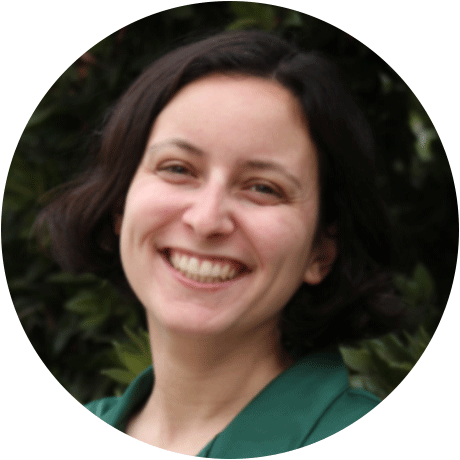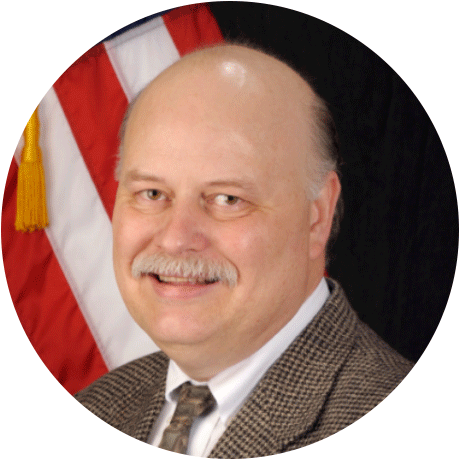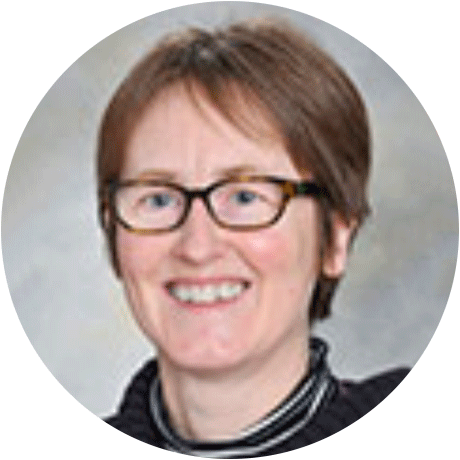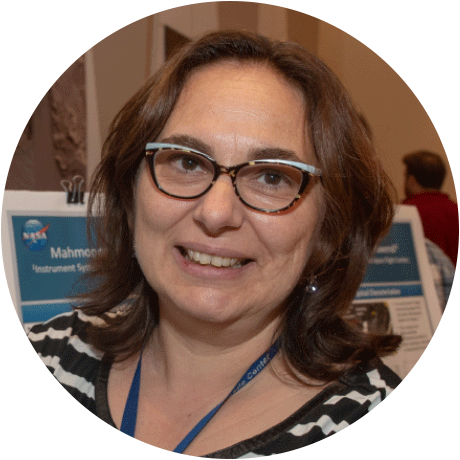The independent judging panels for MagQuest Phases 1, 2, and 3 included distinguished experts in sensors, platform engineering, mission operations and program management, the World Magnetic Model, and geomagnetism.
Judges recused themselves from evaluating any submissions deemed to present a conflict of interest.
Phase 3 judges

Pauline Faure, Ph. D

James Friederich
James Friederich is the Senior GEOINT Officer for Geosciences at the National Geospatial-Intelligence Agency in St. Louis, MO. He provides strategic leadership, requirements validation, and standards development to the Department of Defense and Intelligence Community for the World Geodetic System 1984, specifically in the areas of the Earth’s gravity and magnetic fields. He ensures new technology integration and drives the future state of NGA’s Geomatics tradecraft specialties to meet customer requirements.
Approved for Public Release #19-569

Susan MacMillan, Ph. D
Dr. Susan Macmillan works in the Geomagnetism Team at the British Geological Survey (BGS) in Edinburgh, Scotland and has been involved with the production of the World Magnetic Model since the 1995 revision. For nearly 20 years she has led various projects in BGS concerning global and local magnetic field modelling, and is familiar with the existing observation programmes which provide the data for such models.

Manoj Nair, Ph. D
Dr. Manoj Nair is a senior researcher at NOAA’s National Centers for Environmental Information (NCEI) and at the Cooperative Institute for Research in Environmental Sciences (CIRES), University of Colorado Boulder. Dr. Nair’s research interests include geomagnetic field processing and modeling, time series prediction and electromagnetic induction in the Earth and oceans. Dr. Nair has been involved with the productions of the World Magnetic Model (WMM) and the High Definition Geomagnetic Model (HDGM) since 2010. Dr. Nair leads NOAA’s CrowdMag project that aims to crowdsource geomagnetic data from smartphones. He has authored and co-authored over 60 publications.

J. Brent Parham, Ph. D
Dr. J. Brent Parham is a member of the Technical Staff in the Space Systems Analysis and Test Group at MIT Lincoln Laboratory, where he studies the space environment and its effects on national infrastructure. Dr. Parham received a bachelor’s degree in Aerospace Engineering from MIT, a master’s in Mechanical Engineering from Boston University, and a doctorate in Electrical Engineering from Boston University as part of its Center for Space Physics. During his time at BU, Dr. Parham managed the build of ANDESITE, a novel spacecraft-magnetometer swarm, and studied auroral dynamics with on-board engineering magnetometer data from commercial constellations such as Planet and Iridium.

Eftyhia Zesta, Ph. D
Dr. Zesta has been the Chief of NASA’s Geospace Physics Laboratory since 2012 and is an expert in the physical processes underlying the coupling between the Earth’s magnetosphere, ionosphere, and thermosphere and the impacts of space weather on human activities. Her work experience spans the academic environment, civil space, and the Department of Defense. Dr. Zesta has served on review committees for NASA, NSF and the United States Air Force, and previously led the NSF-funded SAMBA ground magnetometer array along the coast of Chile and in Antarctica.
Phase 1 and 2 judges
Kerri Cahoy, Ph. D. | Associate Professor of Aeronautics and Astronautics, Massachusetts Institute of Technology
Dr. Kerri Cahoy is an Associate Professor of Aeronautics and Astronautics at MIT and leads the Space Telecommunications, Astronomy, and Radiation (STAR) Laboratory. Dr. Cahoy received a B.S. in Electrical Engineering from Cornell University, and M.S. and Ph.D. in Electrical Engineering from Stanford University. Dr. Cahoy previously worked at Space Systems Loral, as a postdoctoral fellow at NASA Ames, and currently leads nanosatellite atmospheric sensing (MicroMAS, MiRaTA), optical communications (NODE, CLICK), and exoplanet technology demonstration (DeMi) missions.
Captain Aaron J. Canciani, Ph. D. | Assistant Professor of Electrical Engineering, Air Force Institute of Technology
Captain Aaron Canciani is an Assistant Professor of Electrical Engineering at the Air Force Institute of Technology. His research primarily focuses on the design and implementation of non-GPS navigation systems as well as developing AI algorithms for navigation. Captain Canciani is leading current Air Force efforts to navigate with Earth magnetic anomaly fields, a promising non-GPS navigation technique.
Arnaud Chulliat, Ph. D. | Research Scientist & Team Lead, University of Colorado Boulder & NOAA/NCEI
Dr. Arnaud Chulliat is the Team Lead of NCEI/CIRES Geomagnetism, a research team affiliated with NOAA’s National Centers for Environmental Information (NCEI) and the Cooperative Institute for Research in Environmental Sciences (CIRES), University of Colorado Boulder. Dr. Chulliat’s research interests include geomagnetic field modeling, data analysis and observation techniques. Prior to joining CIRES in 2014, Dr. Chulliat was the Director of Magnetic Observatories at Institut de Physique du Globe de Paris, where he led the installation of new observatories in Asia and the Pacific Ocean. He has authored and co-authored over 70 publications.
Corey Cochrane, Ph. D. | Technologist / Investigative Scientist, NASA Jet Propulsion Laboratory
Dr. Corey Cochrane is a member of the Advanced Optical and Electro-Mechanical Microsystems Group at NASA’s Jet Propulsion Laboratory (JPL). His primary research interests include the measurement and study of planetary magnetic fields and plasmas. The majority of Corey’s current research is dedicated to the magnetic induction investigation to be performed on the Europa Clipper mission. Corey is also the principal investigator of a next-gen silicon carbide magnetometer, a co-investigator of a gas and ice spectrometer radar and time-resolved Raman spectrometer currently under development at JPL.
Mark Engebretson, Ph. D. | Professor at Augsburg University
Dr. Mark Engebretson is Principal Investigator for the Magnetometer Array for Cusp and Cleft Studies (MACCS) in Arctic Canada and for arrays of induction coil magnetometers in Antarctica, Eastern Canada and Greenland. He has been a member of the Physics Department at Augsburg University since 1976, and has been Director of its Center for Atmospheric and Space Sciences since 1990. Dr. Engebretson has also analyzed magnetic field and energetic particle data from many research satellites including Explorer 45, Polar, Cluster, ST5, and Van Allen Probes, and is author/co-author of 226 refereed scientific publications.
James Friederich | Senior GEOINT Officer-Geosciences, National Geospatial-Intelligence Agency
James Friederich is the Senior GEOINT Officer for Geosciences at the National Geospatial-Intelligence Agency in St. Louis, MO. He provides strategic leadership, requirements validation, and standards development to the Department of Defense and Intelligence Community for the World Geodetic System 1984, specifically in the areas of the Earth’s gravity and magnetic fields. He ensures new technology integration and drives the future state of NGA’s Geomatics tradecraft specialties to meet customer requirements.
Approved for Public Release #19-569
CDR Paul Frontera, USN, Ph. D. | Assistant Professor in the Weapons, Robotics, and Control Engineering Department; United States Naval Academy
CDR Paul Frontera is an Assistant Professor in the United States Naval Academy’s Weapons, Robotics, and Control Engineering Department. Prior to completing his Ph. D. in Mechanical Engineering, he served as a Submarine Warfare Officer aboard four fast attack nuclear powered submarines. His research interests include estimation, managing uncertainty, optimal control, and maritime robotics.
Janet Green, Ph. D. | Founder & CEO, Space Hazards Applications
Dr. Janet Green is a scientist and entrepreneur who founded Space Hazards Applications, which provides science and services for understanding the impact of space weather on technology. Her journey began with analyzing the performance and characteristics of the magnetometer on the Galileo satellite as it investigated the magnetic structure of the solar wind, Earth, Venus, and Jupiter, and led to starting her own business where she has gained a diverse understanding of space physics, space weather instrumentation, operational software product development, and machine learning. Her main interest now is to translate complex scientific understanding into actionable information.
Jesper Gjerloev, Ph. D. | Principal Professional Staff, Johns Hopkins University Applied Physics Laboratory
Dr. Jesper Gjerloev is Principal Professional Staff at the Johns Hopkins University Applied Physics Laboratory, author of some 100 scientific papers of which most are focused on some aspect of magnetosphere-ionosphere physics, and has led a list of projects including NASA mission proposals, science centers and steering committees. His doctoral thesis at the Technical University of Denmark focused on auroral electrodynamics from work performed at NASA-Goddard Space Flight Centre. He is also principal investigator for the SuperMAG and ARCH projects, the Birkeland mission and project scientist for the EZIE and ACES missions.
Thomas Johnson | Small Satellite Project Manager, Goddard Space Flight Center
Mr. Thomas Johnson is the Goddard Space Flight Center’s Small Satellite Project Manager. Mr. Johnson has an extensive background in instrument and spacecraft project management, design, integration, environmental testing, and launch site operations. He has served as the Project Manager for numerous flight instruments that span the Electromagnetic Spectrum and include Near and Mid Infrared, X-Ray, Gamma Ray, and Mass Spectrometer instruments. Mr. Johnson has supported numerous Earth and Space Science missions including JWST, MOMA, Fermi, ICESAT, TRMM, XTE, HST Repair Missions, SAMPEX, EUVE, UARS, BBXRT, and COBE. He has also supported the development of over 10 NASA and NSF CubeSat missions and was the project manager for NASA’s IceCube (first GSFC CubeSat) and HaloSat (NASA’s first Astrophysics CubeSat) missions.
Susan Macmillan, Ph. D. | Senior Scientist, Geomagnetism; British Geological Survey
Dr. Susan Macmillan works in the Geomagnetism Team at the British Geological Survey (BGS) in Edinburgh, Scotland and has been involved with the production of the World Magnetic Model since the 1995 revision. For nearly 20 years she has led various projects in BGS concerning global and local magnetic field modelling, and is familiar with the existing observation programmes which provide the data for such models.
Michael Purucker, Ph. D. | Chief, Planetary Magnetospheres Laboratory; NASA Goddard Space Flight Center
Dr. Michael Purucker is a researcher and manager at NASA, where he studies the role of magnetic fields as fingerprints of processes in, and around, the planets and moons of our solar system. These processes include tectonics, impact, igneous, heat flux, basin development, and solar-magnetosphere interactions.
Gurpartap Sandhoo, D. SC. | Superintendent, Spacecraft Engineering Department; U.S. Naval Research Laboratory
